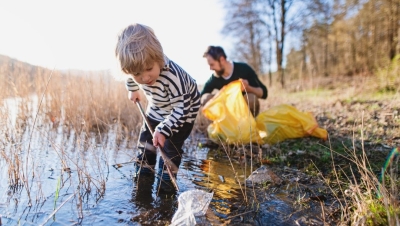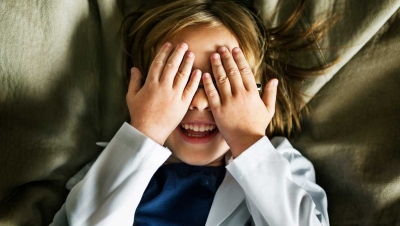Every Thursday morning, three-year-old Tyrone and his mother attend play mornings. This interactive time between mothers and their preschool children is designed to be fun and enriching. Planned playground activities teach mothers positive ways to reinforce their children’s good behaviors, and the two-hour time provides the opportunity for Tyrone to get to know other children and to learn group cooperation.
One would expect Tyrone to enjoy this bonding time with his mother and the opportunity to make friends. As they step out of their car into the parking lot, Tyrone clings to his mother’s leg and begins shrieking at the top of his lungs, “Don’t make me go!”
Certain that all the other mothers and children are staring at her, Tyrone’s mother drags him into the playground shelter, kicking and screaming. She peels him off of her and tries to reassure him. The other mothers and children join in. But it is hopeless. Tyrone’s hysterics have escalated into alligator tears and gulping sobs.
On the other side of town, seven-year-old Madison stands calmly with her teacher. From all outward appearances, she is enjoying a special recess time with a primary role model in her life. Yet, when her teacher encourages her to join her classmates on the monkey bars, Madison begins to have the jitters. Her teacher gives her a gentle push, and the child stiffens her body and freezes. Tears well up in her eyes, and silently drop onto her cheek. As much as she visualizes herself running onto the playground, she cannot bring
herself to do so. Her teacher sighs with disappointment.
Frustrating to both children and parents, social anxiety is a common emotional problem, which may or may not be affected by a child’s mood. However, according to the National Institutes of Mental Health, six percent of children ages nine to seventeen have emotional problems which may contain an anxiety component. The researchers are unsure of the percentage of preschool and early school-age children who experience these uncomfortable feelings.
For children like Tyrone and Madison, mental health professionals advise that caregivers continue to expose children to the playground environment. Virginia Dempsey, a Huntsville, Alabama, child, and family social worker with 30 years experience, emphasizes that children should not be allowed to avoid these social situations.
Dempsey recounts numerous experiences where children became successful in social interactions as a direct result of their parent’s persistence. “Maintain the consistency of the playgroup, praise the child on every step of success - even if his accomplishment is small - and ignore all the negative behaviors, including the screaming and kicking,” Dempsey advises.
She is also an advocate of “exposure therapy.” Dempsey explains that these techniques can be conducted by parents with the support of their pediatrician or a mental health professional.
“Exposure therapy begins with daily rehearsals. These practice sessions between parent and child demonstrate what social behaviors are expected. If there are siblings in the family, they can participate, too. The process then moves to include gradual exposure to the social environment.
“The parent might reintroduce the child to the playground when no one else is there. Parent and child can walk around, and the child can be encouraged – but not forced – to touch the playground equipment.
“Parents also need to listen to what their child is saying. A previous playground crisis, such as an accident or a bully, may have caused trauma.
“Once the rehearsals begin, it is imperative that they be fun,” cautions Dempsey. If they are not, the child can become more fearful. Fun is what brings success. For example:
“Let’s discuss a childlike Tyrone,” Dempsey explains. “His parents might make sock characters and create a puppet show involving play mornings. The puppets are having fun playing with each other. Their play might initially be parallel, where one puppet plays on a swing, while another plays on a bridge located near-by. In the show, they could call out to each other:
‘Watch me swing!’
‘Watch me jump on the bridge!’”
Dempsey continues, “After the child has actually spoken to another child or two during a play morning, the puppet show could move to cooperative play, where the characters build a sandcastle in the sandbox or play together in the tree house.
“Concurrently with the puppet shows, the parents are playing with their child, emulating the actions of the puppets at first, and then varying the language to give the activity a sense of normalcy.”
“In the case of Madison, reassurance and rehearsal are key techniques,” recommends psychologist Chris Karcher, a California native who received his postdoctoral training at the Institute for Child and Adolescent Development in Wellesley, MA.
“Madison needs to know that she has her parents’ as well as her teacher’s permission to enjoy play. Some of the questions I wonder about include:
“Are her parents socially interested in each other? Do they go out together for fun times? Do her parents have friends who visit in their home?
“Does the family participate in recreational activities? Are the children taught to enjoy each other? Are there times when her home is filled with laughter or silliness? “If the answers are yes, Madison has a good chance of social success because social activity is being modeled for her. Too often, parents have the expectation of social success for their children while never participating in social events themselves.
“Parental example remains the greatest teaching example for a child,” Karcher affirms. “It is much stronger than words.
“Assuming that Madison has social role modeling at home,” Karcher continues, “her parents and teacher might try the following:
“Madison’s teacher might invite an empathetic classmate to be a play companion for a couple of weeks. The teacher could help them select a playground activity and rehearse it together prior to going onto the playground. This would help Madison build confidence. As she becomes more secure, the teacher could encourage other children to participate with the duo, until Madison is socially integrated.”
Karcher adds that problems such as Madison’s are not uncommon in families with an only child, nor are they uncommon in families where one parent experienced shyness as a child.
“We are just now uncovering the genetic links,” he reports, “and neuro-psychologists believe the problem originates in the area of the brain called the amygdala. While it is a relatively tiny part of the brain, scientists know it is where our ‘fight or flight’ response is located, and it plays a role in the production of brain chemicals which stimulate feelings of jitteriness, muscle tension, and the sense that everybody is watching us.
“While I don’t advocate medicine for all children,” Karcher concludes, “in cases where social anxiety is combined with fears about other things, the child’s pediatrician should be consulted.”
Social anxiety is a frequent problem for older children as well. Combined with emerging hormones, the reaction to anxious social situations proves embarrassing. Sweating, blushing, nausea, klutziness, headaches, stomach aches and a diminished ability to concentrate or find the right words to say are a few of the symptoms.
Julio, a 12-year-old, routinely experienced this when his peers encouraged him to join in playground basketball. Liesl, age 11, found herself in a similar situation when she and her girlfriends walked over to the playground to sit on the swings and talk.
Surprised by their inability to think straight or speak correctly, the preteens spoke with their school counselor. She advised them to imagine the worst that might happen and to think through the situation. For Julio, it was missing each basket; for Liesl, it was the fear of sounding stupid in front of her friends.
With their counselor, each child visualized the “worst case” scenario, thought through it and established an action plan, should the situation ever arise. The counselor then helped them develop a safety plan that they could enact if the situation was beginning to occur. For both preteens, it involved being proactive rather than reactive. Julio decided that he would suggest trading positions where the expectation that he shoot consistently would be lowered. Liesl decided she would take a tip from the “designated driver” motto and would tell her friends that she would be the “designated listener.”
The counselor then presented each student with a tape recorder and recommended that they practice both speaking into it and listening to their recordings. “This way,” she said, “you can get used to speaking up for yourself, and you will be used to hearing the sound of your own voice. When difficult social situations occur, you will know exactly how to handle them.”
For children like Tyrone, Madison, Julio, and Liesl, social anxiety may always be a part of their lives. However, with proper coaching from reassuring adults, they can learn to accept their feelings and push through their fears. They can become active participants in life as opposed to spectators on the sidelines.





Add new comment